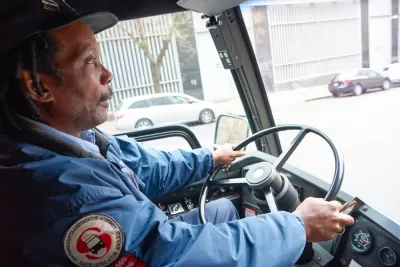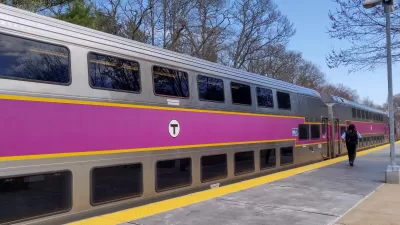Free transit would reduce boarding times and improve working conditions for bus drivers, the 'frontline workers' responsible for fare collection and enforcement.

As the Massachusetts Bay Transportation Authority (MBTA) launches a fare-free pilot program on Boston's heavily used Route 28 bus, "Abdallah Fayyad urges city and MBTA officials to study not only the effect of free fares on ridership but also their effect on the bus drivers." Sandy Smith reports on Fayyad's essay, in which he argues that eliminating fares would also benefit bus drivers, "the frontline workers responsible for collecting fares and enforcing fare policy."
Bus drivers routinely "face both verbal and physical abuse from riders when they do discourage fare evasion," and "even if violence never occurs, the competing pressures of time and policy enforcement lead to arbitrary and capricious application of policy." In 2008, "a New York City bus driver was fatally stabbed over an unpaid fare." Meanwhile, "punishment for fare evasion falls disproportionately on the shoulders of Black and brown passengers."
According to Fayyad, "free public transit would create more equitable cities and increase people’s mobility. And beyond the benefits to residents and commuters, a fare-free transit system would undoubtedly improve working conditions for bus drivers."
FULL STORY: Another Group That Would Benefit from Free Transit: Bus Drivers

Planetizen Federal Action Tracker
A weekly monitor of how Trump’s orders and actions are impacting planners and planning in America.

Map: Where Senate Republicans Want to Sell Your Public Lands
For public land advocates, the Senate Republicans’ proposal to sell millions of acres of public land in the West is “the biggest fight of their careers.”

Restaurant Patios Were a Pandemic Win — Why Were They so Hard to Keep?
Social distancing requirements and changes in travel patterns prompted cities to pilot new uses for street and sidewalk space. Then it got complicated.

Platform Pilsner: Vancouver Transit Agency Releases... a Beer?
TransLink will receive a portion of every sale of the four-pack.

Toronto Weighs Cheaper Transit, Parking Hikes for Major Events
Special event rates would take effect during large festivals, sports games and concerts to ‘discourage driving, manage congestion and free up space for transit.”

Berlin to Consider Car-Free Zone Larger Than Manhattan
The area bound by the 22-mile Ringbahn would still allow 12 uses of a private automobile per year per person, and several other exemptions.
Urban Design for Planners 1: Software Tools
This six-course series explores essential urban design concepts using open source software and equips planners with the tools they need to participate fully in the urban design process.
Planning for Universal Design
Learn the tools for implementing Universal Design in planning regulations.
Heyer Gruel & Associates PA
JM Goldson LLC
Custer County Colorado
City of Camden Redevelopment Agency
City of Astoria
Transportation Research & Education Center (TREC) at Portland State University
Camden Redevelopment Agency
City of Claremont
Municipality of Princeton (NJ)





























